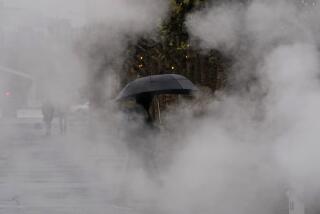Infrastructure Not in ‘Ruins’ but Gets Only a ‘C+’ : Official Calls for More Public Works Spending
A member of a federal council studying the nation’s highways, bridges, dams and other public works said Sunday that the country’s infrastructure deserves a “C+” grade and can be expected to deteriorate further if spending on public works does not increase.
“The demand for vital public works services is increasing faster than underlying physical capacity,” Lowell B. Jackson, executive director of the Colorado Department of Highways and one of five members of the National Council on Public Works Improvement, said in Anaheim. “In short, we are living off past investments.”
While America is “not really slipping into ruins,” Jackson said, still, “We can take less for granted.”
Jackson, 56, was speaking to about 1,500 members of the American Society of Civil Engineers, which is holding its annual convention this week at the Disneyland Hotel.
The five-member council--three of whose members were appointed by President Reagan and two by Congress after the passage of the Public Works Improvement Act of 1984--will probably release its final report on the nation’s infrastructure by the end of the year, Jackson said.
The council currently is debating a recommendation that the nation set a goal to increase spending on new public works projects (apportioned among all levels of government) “by as much as 50% to 100% over current levels,” Jackson said.
Such a large increase would involve new taxes, user fees, debt financing and the retraction of some state constitutional limits regarding local taxes, he said.
In California alone, just the maintenance and replacement of worn-out existing highways costs about $800 million a year, a state Transportation Commission member said in 1986. New highways have been projected to cost more than $20 billion between now and the year 2000, according to the Automobile Club of Southern California.
In an interview after Sunday’s address, Jackson--conceding that he was not familiar with the particular strengths and weaknesses of Southern California’s infrastructure--commented on the area’s transportation problems.
“You’re probably not going to be able to build your way out of the problem--I’m not sure where you’d find the room,” he said. “You can expand them (highways and major roads) where you can; but where you can’t, you’re going to have to use a lot more demand management--ramp metering, car pool lanes, that sort of thing.
“It’s going to require some behavior changes on the part of the consumer . . . and that will be politically difficult.”
Jackson’s comments Sunday represented his own opinions, he said, and not necessarily the consensus of the council.
More to Read
Sign up for Essential California
The most important California stories and recommendations in your inbox every morning.
You may occasionally receive promotional content from the Los Angeles Times.










